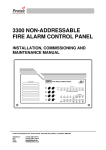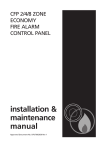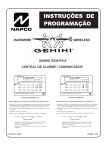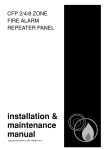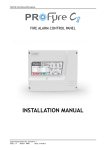Download Ptotec 3100 User manual
Transcript
3200 NON-ADDRESSABLE FIRE ALARM CONTROL PANEL INSTALLATION, COMMISSIONING AND MAINTENANCE MANUAL Protec Fire Detection PLC, Protec House, Churchill Way, Nelson, Lancashire, BB9 6RT. Telephone: Fax: Web: Email: +44 (0) 1282 717171 +44 (0) 1282 717273 www.protec.co.uk [email protected] Document Revision Details Issue Author Date 0 Modification Detail Document Creation NH 23/06/05 1 Remove reference to fire link interface RB 18/04/07 2 Refer to ECN3367 NH 23/05/13 93-331-73 Issue 2 Page 2 of 32 © Protec Fire Detection PLC 2013 Table of Contents 1.0 3200 SYSTEM OVERVIEW..................................................................................................................................... 4 2.0 IMPORTANT NOTES – PLEASE READ ................................................................................................................. 5 3.0 ITEMS SUPPLIED WITH THE 3200 PANEL .......................................................................................................... 6 4.0 CABLING REQUIREMENTS .................................................................................................................................. 7 4.1 4.2 DETECTOR, ALARM AND AUXILIARY WIRING...................................................................................................... 7 MAINS WIRING .................................................................................................................................................... 7 5.0 INSTALLATION PROCEDURE .............................................................................................................................. 8 6.0 TESTING OF CABLING PRIOR TO CONNECTION............................................................................................... 9 7.0 DETECTOR CIRCUIT CONNECTIONS ................................................................................................................ 10 8.0 ALARM CIRCUIT CONNECTIONS ....................................................................................................................... 11 9.0 AUXILIARY INPUT AND OUTPUT WIRING ......................................................................................................... 12 9.1 9.2 9.3 9.4 9.5 10.0 10.1 10.2 10.3 11.0 11.1 11.2 12.0 12.1 12.2 12.3 12.4 12.5 12.6 KEYSWITCH INPUT ............................................................................................................................................. 12 REMOTE ALARM INPUT ...................................................................................................................................... 12 CLASS CHANGE INPUT ....................................................................................................................................... 12 GLOBAL FAULT OUTPUT .................................................................................................................................... 12 GLOBAL FIRE OUTPUT ....................................................................................................................................... 12 COMMISSIONING ................................................................................................................................................. 13 CONNECTING THE MAINS ................................................................................................................................... 13 CONNECTING THE BATTERIES ........................................................................................................................... 14 SWITCHING ON .................................................................................................................................................. 14 PROGRAMMING OVERVIEW .............................................................................................................................. 15 ACCESS LEVELS ................................................................................................................................................. 15 ZONE PROGRAMMING CHOICES ......................................................................................................................... 16 PROGRAMMING DETAILS .................................................................................................................................. 17 PROGRAMMING ZONE DISABLEMENTS............................................................................................................... 18 PROGRAMMING ALARM DISABLEMENTS............................................................................................................ 19 PROGRAMMING ZONES INTO TEST MODE .......................................................................................................... 20 PROGRAMMING COINCIDENCE ZONES................................................................................................................ 21 PROGRAMMING NON-LATCHING ZONES ............................................................................................................ 22 PROGRAMMING THE DETECTION ZONE END OF LINE MONITORING TYPE .......................................................... 23 13.0 FAULT RECTIFICATION GUIDELINES ............................................................................................................... 24 14.0 3200 TECHNICAL SPECIFICATION .................................................................................................................... 25 15.0 3200 FEATURES SPECIFICATION ...................................................................................................................... 26 APPENDIX 1 - ACCESSORIES AVAILABLE FOR THE 3200. ....................................................................................... 27 APPENDIX 2 - 3200 SPARES LIST.................................................................................................................................. 28 APPENDIX 3 - 3200 MAIN PCB. DETAILS ...................................................................................................................... 29 APPENDIX 4 - 3200 PROGRAMMING QUICK REFERENCE GUIDE ............................................................................. 30 93-331-73 Issue 2 Page 3 of 32 © Protec Fire Detection PLC 2013 1.0 3200 System Overview The Protec 3200 fire alarm system features: • 2 detection zones. • 2 monitored alarm circuits rated at 150mA each. • Common negative (allowing three wire operation). • Re-sounding of outputs if a zone changes from automatic to manual activation • Three auxiliary inputs: Keyswitch, Class Change and Remote Alarm. • Global Fire and Global Fault clean contact connections. • Monitored Auxiliary 24V output (Overload Protected, 100mA maximum). • Capacitive or resistive detector circuit end of line monitoring (programmable). • Extensive range of engineering functions accessed via 5 digit entry codes: • • • • • • • Disablement of zones. Coincidence operation. Test zones. Non-latching zones. Disablement of alarm circuits. End of line type selection. Low quiescent current of 15mA (24V dc supply, mains fail fault, no external equipment). Note: Due to a policy of continuous improvement Protec Fire Detection plc. reserve the right to alter the specification without prior notice. 93-331-73 Issue 2 Page 4 of 32 © Protec Fire Detection PLC 2013 2.0 Important Notes – PLEASE READ • THE FIRE ALARM PANEL AND ITS ASSOCIATED CONNECTIONS MUST BE INSTALLED, COMMISSIONED AND MAINTAINED BY A SUITABLY SKILLED AND COMPETENT PERSON. • THIS EQUIPMENT MUST BE EARTHED. • THIS EQUIPMENT IS NOT GUARANTEED UNLESS INSTALLED AND COMMISSIONED IN ACCORDANCE WITH CURRENT NATIONAL STANDARDS. • THIS EQUIPMENT HAS BEEN DESIGNED AND MANUFACTURED TO CONFORM WITH THE REQUIREMENTS OF ALL APPLICABLE EU COUNCIL DIRECTIVES. • THIS MANUAL MUST BE THOROUGHLY READ AND UNDERSTOOD BEFORE INSTALLATION AND COMMISSIONING OF THIS EQUIPMENT IS UNDERTAKEN. 93-331-73 Issue 2 Page 5 of 32 © Protec Fire Detection PLC 2013 3.0 Items Supplied with the 3200 panel • Installation, Commissioning and Maintenance manual. • User manual. • Mounting template. • Accessory pack, comprising: • • • • • • • 2 x 100µF/22Ω detector circuit end of line units 2 x 10k alarm circuit end of line units 1 x red battery lead 1 x black battery lead 1 x inter-battery connection lead 1 x 1 Amp HRC power supply fuse 1 x 1 Amp anti-surge battery fuse 93-331-73 Issue 2 Page 6 of 32 © Protec Fire Detection PLC 2013 4.0 Cabling Requirements 4.1 Detector, Alarm and Auxiliary Wiring All external wiring associated with the system must conform to the current I.E.E Regulations and cabling must conform to the relevant BS specifications. ECA recommended Cable Separation for Electromagnetic Compatibility in Buildings must be followed. To comply with EMC regulations Protec recommends the use of screened cabling throughout the installation. The screens must be securely connected to the screwed earthing studs provided inside the 3200 enclosure. Screened cables that are suitable for wiring are: TM TM TM MICC (Pyro ), Pirelli FP200 , FireTuff , or any other cable which complies with BS 6387 (categories C, W, Z). Proper glanding of the cable is vital for the correct performance of the system. 4.2 Mains Wiring The 3200 requires a mains supply exclusive to the panel that uses fixed three core wiring (between 2 2 0.75mm and 2.5mm ) which is fed from an isolating fused spur, fused at 3A. Unauthorised operation of the mains supply should not be allowed and the fused spur should be labelled “FIRE ALARM: DO NOT SWITCH OFF” Important Note: Do not connect the mains wiring to the control panel until all other connections (detector circuits, alarm circuits, auxiliary inputs/outputs) have been checked. 93-331-73 Issue 2 Page 7 of 32 © Protec Fire Detection PLC 2013 5.0 Installation Procedure The 3200 fire alarm panel circuit boards are housed in a metal enclosure. This enclosure has a lockable metal front door (holding the display board). The panel can be surface or flush mounted (a bezel is required for flush mounting). The panel must be located internally in an area that is not subject to dampness, extremes of temperature or physical abuse. The environmental limits are given in Section 21 1) Unpacking After opening the box, remove the installation template from the packaging, leaving the 3200 in the cardboard box for protection. 2) Preparing the Mounting Position Use the installation template in conjunction with a spirit level to mark out the fixing locations for the panel. Drill and plug the three mounting holes previously marked. 3) Removal of the Main Board. NOTES ON ANTI-STATIC HANDLING OF THE PCBs Before handling any of the circuit boards in the 3200 it is vital that any operatives discharge themselves of any static charge that may have built up on them. This can be done by momentarily touching a solid earth point (a non-painted part of a radiator, for example). Handle the PCB. by its sides and DO NOT touch the electronic components. The PCB. should be stored in a clean, dry place away from the place of work. Retain the PCB. in a cardboard box for safety until it is required. Disconnect the 16 way display board ribbon cable from the main PCB. Take care not to strain the PCB. Remove the supplementary earth cable from the mains terminal block. Unscrew the five posidrive screws on the main PCB. Then remove the PCB, the screws (and any washers) and the power supply insulation sheet and place them in the cardboard box for protection. 4) Preparing and Fixing the Unit Using the installation template, mark out suitable positions for cable entry on the top of the enclosure (not behind the main board or battery locations). The mains cable entry position should be kept away from other system cabling. Drill out the cable entry positions and mount the enclosure at the position prepared in (2) whilst feeding the cables into the enclosure. Ensure any metal swarf is completely removed from the enclosure before the main PCB. is refitted. 93-331-73 Issue 2 Page 8 of 32 © Protec Fire Detection PLC 2013 5) Refitting of the Main Board NOTE: Do not over-tighten any screws. Refit the power supply insulation sheet over the PCB mounting pillars. Replace the main PCB and refit the five posidrive screws. Ensure the top right screw includes a metal star washer to maintain earth connectivity. Reconnect the 16-way ribbon cable from the display board, and reconnect the supplementary earth connection to the mains input terminal block. 6.0 Testing of Cabling Prior to Connection Before connecting any external cables to field device (detectors, sounders, auxiliary inputs or outputs), TM or the 3200, tests must be carried out using a 500V dc insulation tester (Megger ). The readings between each cable core, and each core and earth should be greater than 10MΩ. Important Notes: • Equipment connected to the cabling during insulation tests could be damaged with the high voltages produced during the test. • Field devices and the 3200 MUST NOT be connected when high voltage insulation tests are being performed on the cabling. • The cabling must be completely discharged prior to connection to any field devices or the 3200. 93-331-73 Issue 2 Page 9 of 32 © Protec Fire Detection PLC 2013 7.0 Detector Circuit Connections Figure 7 shows a typical connection regime for a detector zone on the 3200. Figure 7.0 Typical 3200 Detector Connection • Ensure the length of the zone wiring is no more than 500 metres. • Ensure the resistance of each conductor is no more than 15Ω. • Ensure the capacitance of the zone wiring is no more than 0.27µF (micro-Farads) when no end of line capacitor is present. • The end of line unit (8.2kΩ resistor or 100µF/22Ω network) must be placed at the very end of the detector zone wiring, to ensure the whole zone is monitored. • Spurs should not be connected from the zone wiring, as a spur cannot be monitored for open circuit faults. • To ensure compliance with EN54 Part 2 each detector base must include a series low voltage drop diode, so that manual call points following a removed detector still function correctly. Protec S3000 bases incorporate the diode as standard. • Manual call points must incorporate a series resistor to ensure the zone does not enter a short circuit fault condition when the manual call point is activated. If the panel is to be able to distinguish between automatic and manual zone activation. The resistor value in the manual call point must be 180Ω. In retrofit situations, values up to 560Ω can be used but the ‘MCP Fire’ indication may not be given in all cases. Protec 3100 manual call points incorporate the series resistor as standard. 93-331-73 Issue 2 Page 10 of 32 © Protec Fire Detection PLC 2013 8.0 Alarm Circuit Connections The 3200 has two alarm circuit outputs, rated for continuous use at 150mA and protected from overload by an auto resetting thermal ‘fuse’. The ‘fuse’ will reset when the cause of overload has been removed and the alarm output has been de-activated. Figure 8 shows typical connections for a alarm circuit. Figure 8.0 Typical Alarm Circuit Connection. • Ensure the length of the alarm circuit wiring is no more than 500 metres. • Ensure the capacitance of the alarm circuit wiring is no more than 0.27µF (micro-Farads). • The 10kΩ end of line resistor must be connected at the very end of the alarm circuit wiring, to ensure the whole line is monitored for open circuit faults. • Spurs should not be connected from the alarm wiring, as the spur cannot be monitored for open circuit faults. • Only polarised and suppressed sounders should be used on the 3200 alarm circuits. Failure to use polarised sounders will result in an alarm circuit fault. All Protec S3000 sounders are polarised and suppressed as standard. • Efforts should be made to evenly spread the sounder load across the two alarm circuits, to avoid overloading either of the alarm outputs. • It is acceptable to connect alarm circuits 1 and 2 in parallel (to obtain a drive rating of 300mA continuous), however the end of line resistor value must be changed to 4k7Ω 1/2W 5%. This is detailed in figure 8.1 1 2 Figure 8.1 93-331-73 Issue 2 Enhanced Alarm Circuit Drive Details Page 11 of 32 © Protec Fire Detection PLC 2013 9.0 Auxiliary Input and Output Wiring The auxiliary input connections (Keyswitch, Remote Alarm and Class Change) and auxiliary output connections (Global Fault and Global Fire) should be wired in screened cable. The screen should be securely connected to the screwed earthing posts provided in the 3200. 9.1 Keyswitch Input The keyswitch input is active when a short circuit (less than 50Ω) is connected across the keyswitch terminals. In the standard 3200 this is an alternate method of accessing level 2 functions if the code entry feature is not required. The keyswitch wiring should be kept local to the 3200. 9.2 Remote Alarm Input The remote alarm input is active when a short circuit (less than 50Ω) is placed across the remote alarm terminals. When active the 3200 will activate alarm outputs, fast pulse the internal buzzer and illuminate the ‘General Fire’ indicator. The Global Fire output is NOT activated. 9.3 Class Change Input The class change input is active when a short circuit (less than 50Ω) is connected across the Class Change terminals. When active the 3200 will activate alarm outputs continuously. The Global Fire output is NOT activated. 9.4 Global Fault Output The Global Fault output is a set of Volt free relay changeover contacts (rated at 1A 24V dc max.) to allow interfacing to other equipment. The contacts are normally activated (the N/C and COM contacts are high resistance) and will release when the 3200 detects a fault. 9.5 Global Fire Output The Global Fire output is a set of Volt free relay changeover contacts (rated at 1A 24V dc max.) to allow interfacing to other equipment. The contacts are normally released (the N/C and C contacts are low resistance) and operate as follows: The Global Fire output WILL activate if: • • A standard zone has activated (MCP or automatic) A coincidence zone has expired, or the second zone has activated The Global Fire output WILL NOT activate if: • • • • A remote alarm activation occurs A zone in test mode is activated A non-latching zone is activated The Sound Alarms button is pressed in access level 2 or 3 93-331-73 Issue 2 Page 12 of 32 © Protec Fire Detection PLC 2013 10.0 Commissioning 10.1 Connecting the Mains Important Note: • Pay particular attention that the earth cable is firmly connected to the earth terminal of the power supply, and that the earth strap from the main PCB. to the main panel metalwork is sound. After making and checking the connections to the control panel detailed in previous sections, the power supply may be connected to the incoming mains supply. Ensure the fused double pole isolator is in the ‘OFF’ position then connect the incoming mains cable to the appropriate terminals on the power supply PCB (see figure 12.0). Figure 12.0 93-331-73 Issue 2 Power Supply Terminal Details Page 13 of 32 © Protec Fire Detection PLC 2013 10.2 Connecting The Batteries Next, connect two new and fully charged 12V 2.2Ah Valve Regulated Sealed Lead Acid Batteries (SLA) in series as shown in figure 12.1 Figure 12.1 10.3 Installation of Standby batteries Switching On Switch the fused isolator ‘ON’. The ‘Supply Present’ indicator will illuminate on the front of the panel. Assuming all other connections are correct and the end of line units are present (and correct), no other faults should be displayed. The 3200 is now ready to be programmed. 93-331-73 Issue 2 Page 14 of 32 © Protec Fire Detection PLC 2013 11.0 Programming Overview The 3200 has many programming features, making it extremely flexible. These can be accessed by users at different authorisation levels. The programming features and authorisation levels are detailed below. 11.1 Access Levels Access Level 1 (User code not entered) The panel’s front panel display indicators are visible, providing a clear status of the 3200. The functions that may be performed at access level 1 are: • Muting of the panel’s internal buzzer. • Entry of the 5 digit user code to access level 2 functions. • Entry of the 5 digit engineer code to access level 3 functions. Access Level 2 (User code entered) Only authorised users are permitted access to level 2 functions, these are: • Silencing an alarm condition. • Sounding the alarms. • Resetting the panel after an alarm activation. • Testing the front panel indications, and internal buzzer. • Programming a zone into test mode. • Disabling detector circuits. • Disabling alarm circuits. 93-331-73 Issue 2 Page 15 of 32 © Protec Fire Detection PLC 2013 Access Level 3 (Engineer Controls) Only engineers are permitted access to level 3 functions, these are: • All level 2 functions, plus • The programming of coincidence zones. • The programming of non-latching zones. • The programming of the detector circuit end of line type (capacitive or resistive). 11.2 Zone Programming Choices Each zone of the 3200 may be programmed in the following manner. • Non-latching mode. • Coincidence mode. • Test mode. Please not that a zone can only be programmed with one of the choices (ie. a zone cannot be set-up as non-latching and coincidence) non-latching mode overrides coincidence mode. Test mode overrides all other programming. 93-331-73 Issue 2 Page 16 of 32 © Protec Fire Detection PLC 2013 12.0 Programming Details In general the front panel buttons and some indications have the following alternate functions when the 3200 is in programming mode. When Access Level 3 programming functions are being performed the 'Level 3 Accessed' indicator will be illuminated and the ‘Supply Present’ indicator will flash. Button 1 Button 2 Button 3 Button 4 Toggle zone 1 state. Toggle zone 2 state. Scroll. Back / Exit / Program. General Test Indicator General Disablement Alarm Outputs Disabled Programming of zones into test mode Programming of zone disablements Programming of alarm disablements Alarm Fault PSU Fault Aux 24V. Fault Programming of EOL. type Programming of non-latching zones Programming of zones into coincidence 93-331-73 Issue 2 Page 17 of 32 © Protec Fire Detection PLC 2013 12.1 Programming Zone Disablements One or both of its detector zones can be disabled. When a zone is disabled both faults and activations are inhibited. 1. From access level 1 enter the 5 digit user code 1 3 4 4 2. The ‘Level 2 Accessed’ indicator will illuminate. 2. Press button 2 once – The ‘General Disablement’ indicator will illuminate to show the zone disablement option is selected (the normal front panel display is temporarily replaced with the programming display). Any current disablements will be displayed on the zone fire indicators. 3. Press button 1 (zone 1) or button 2 (zone 2) to toggle - disabled / not disabled. 4. Press button 4 to accept and program the disablement set-up and return to access level 2. 5. Press button 4 to return back to access level 1. The yellow ‘General Disablement’ indicator will be illuminated steady, together with the yellow disablement indicator for the relevant zone(s). Figure 14.0. Example of the display when disabling zone 1. 93-331-73 Issue 2 Page 18 of 32 © Protec Fire Detection PLC 2013 12.2 Programming Alarm Disablements Both alarm circuits can be disabled. When alarm circuits are disabled both faults and activations are inhibited. Individual Alarm circuits cannot be disabled. 1. From access level 1 enter the 5 digit user code 1 3 4 4 2. The ‘Level 2 Accessed’ indicator will illuminate. 3. Press button 2 to enter programming mode, the 'General Disablement' indicator will illuminate. 4. Press button 3 until the 'Alarm Outputs' indicator lights. 5. Press button 1 to toggle the alarm circuits - disabled / not disabled. If the alarm circuit is disabled the zone 1 fire indicator will be illuminated. 6. Press button 4 to accept and program the disablement set-up and return to access level 2. 7. Press button 4 to return back to access level 1. The yellow ‘General Disablement’ indicator will be illuminated steady, together with the yellow ‘Alarm Outputs’ indicator. Figure 14.1. Example of the display when disabling the alarm outputs. 93-331-73 Issue 2 Page 19 of 32 © Protec Fire Detection PLC 2013 12.3 Programming Zones Into Test Mode To aid the required fire alarm test schedule, zones can be put into ‘test mode’. In this mode, an alarm on the test zone activates the alarm outputs for 4 seconds then automatically resets. This allows a zone of detectors to be tested without having to manually reset the panel after each activation. The Global Fire Contacts are not activated when the test zone goes into alarm. Alarms on non-test zones will prevent the automatic reset. The procedure for programming a zone into test is given below. 1. From access level 1 enter the 5 digit user code 1 3 4 4 2. The ‘Level 2 Accessed’ indicator will illuminate. 2. Press button 2 to enter programming mode, the 'General Disablement' indicator will illuminate. 3. Press button 3 until the 'General Test' indicator lights. Any zones currently in test mode will be displayed on the zone fire indicator. 4. Press button 1 (zone 1) or button 2 (zone 2) to toggle - test mode / not in test mode. 5. Press button 4 to accept and program the disablement set-up and return to access level 2. 6. Press button 4 to return back to access level 1. The yellow ‘General Test’ indicator will be illuminated steady, showing that at least one zone has been programmed into test mode. Any zones programmed into test mode will have their test indicator illuminated steady. Important Note: • Ensure zones are removed from test mode when testing of the system is complete. Figure 14.2. Example of display when programming zone 2 into test mode. 93-331-73 Issue 2 Page 20 of 32 © Protec Fire Detection PLC 2013 12.4 Programming Coincidence Zones Note. The 3200 will no longer be EN54 compliant if zones are programmed as coincidence zones. It is possible to program the zones as coincidence zones. This mode is used where the consequence of a false alarm is onerous (for example if the panel is connected to an extinguishing system). In this case, both zones must activate before the alarms sound or the Global Fire Contacts activate. When only one coincidence zone activates the panel will flash the relevant zone indicator, fast pulse the internal sounder and wait for one of the following to occur: • • • The second zone to activate. A 2 minute time out from the first activation, to expire. A manual call point activation on any, non-disabled, zone to occur. The 3200 then activates its alarm outputs and global fire contacts. If the cause of the first activation is found genuine, the ‘Sound Alarms’ button can be pressed at access level 2 or 3 to activate the alarm outputs. If the cause is found to be a false alarm the ‘Silence Alarms’ and ‘Reset Panel’ buttons can be pressed. The procedure for programming the zones as coincidence is given below. 1. From access level 1 enter the 5 digit engineer code 1 3 4 2 4. The ‘Level 3 Accessed’ indicator will illuminate and the 'Supply Present' indicator will flash. 2. Press button 2 to enter programming mode, the 'General Disablement' indicator will illuminate. 3. Press button 3 until the 'Aux. 24V Fault’ indicator lights. 4. Press button 1 to toggle the coincidence set up. Zone 1 fire indicator will be illuminated when the zones are programmed as coincidence. 5. Press button 4 to accept and program the coincidence set-up and return to access level 3. 6. Press button 4 to return back to access level 1. No visible indication is available on the front panel to show that zones are set up as coincidence. Tick the relevant box on the system set-up label (fitted inside the 3200 door). Figure 14.3. Example of display when programming the zones as coincidence. 93-331-73 Issue 2 Page 21 of 32 © Protec Fire Detection PLC 2013 12.5 Programming Non-Latching Zones It is possible to program one, or more of the detector zones to operate non-latching. In this mode the zone activates as normal, but when the cause of the activation is removed the 3200 will reset. The Global Fire contacts do not operate. This feature is used when connecting fire alarm systems together to ensure a ‘latch-up’ situation cannot occur when each panel triggers the other due to latched zone activations. 1. From access level 1 enter the 5 digit engineer code 1 3 4 2 4 . The ‘Level 3 Accessed’ indicator will illuminate and the 'Supply Present' indicator will flash. 2. Press button 2 to enter programming mode, the 'General Disablement' indicator will illuminate. 3. Press button 3 until the 'Power Supply Fault' indicator illuminates. Any zones currently as nonlatching will be displayed on the zone fire indicator. 4. Press button 1 (zone 1) or button 2 (zone 2) to toggle - non-latching / latching. 5. Press button 4 to accept and program the non-latching set-up and return to access level 3. 6. Press button 4 to return back to access level 1. No visible indication is given on the front panel to show that zones are programmed as non-latching. Tick the relevant box on the system set-up label (fitted inside the 3200 door). Figure 14.4. Example display when programming zones 1 and 2 as non-latching 93-331-73 Issue 2 Page 22 of 32 © Protec Fire Detection PLC 2013 12.6 Programming the Detection Zone End of Line Monitoring Type The standard detection zone end of line monitoring for the 3200 is capacitive. In certain retrofit situations it may be advantageous to switch the end of line monitoring to resistive. Note: When the 3200 is programmed for resistive end of line monitoring it is no longer EN54 compliant. The procedure for programming the detection zone end of line type is as follows. 1. From access level 1 enter the 5 digit engineer code 1 3 4 2 4. The ‘Level 3 Accessed’ indicator will illuminate and the 'Supply Present' indicator will flash. 2. Press button 2 to enter programming mode, the 'General Disablement' indicator will illuminate. 3. Press button 3 until the 'Alarm Fault' indicator lights. 4. Press button 1 to toggle - resistive / capacitive end of line monitoring. Resistive monitoring is selected when zone 1 fire indicator will be illuminated. 5. Press button 4 to accept and program the end of line set-up and return to access level 3. 6. Press button 4 to return back to access level 1. No visible indication is given on the front panel to show how the zone end of line monitoring is set-up. Tick the relevant box on the system set-up label (fitted inside the 3200 door). Figure 14.5. Example of display when programming the EOL. Type as resistive 93-331-73 Issue 2 Page 23 of 32 © Protec Fire Detection PLC 2013 13.0 Fault Rectification Guidelines Fault Detector Circuit Fault Suggested Action Disconnect the faulty zone and connect a correct end of line unit (resistive or capacitive) directly at the 3200 zone terminals. If the zone fault clears the zone wiring, end of line unit and detector base connections should be thoroughly investigated, and any faults rectified. In particular check that all detectors are connected properly into their bases. If the fault remains check the end of line programming (see section 14.6) and ensure it is set-up for the type of end of line monitoring being used. If the fault still remains either the end of line, or the main board is faulty. Alarm Open Circuit Fault Disconnect the faulty alarm circuit and connect an end of line unit directly at the 3200 alarm terminals. If the alarm fault clears the alarm wiring, end of line unit and sounder connections should be thoroughly investigated, and any faults rectified. In particular ensure all sounders are polarity protected and suppressed. If the fault remains the main board is suspect and should be replaced. System fault An internal software fault has been detected. Enter the user code, press Silence then Reset . If the fault re-appears within 2 minutes the main board is suspect and must be replaced. Power supply fault A fault has been detected in the power supply, charger or batteries. Verify the integrity of the mains input. If it is acceptable, check the mains fuse (FS1) has not ruptured, replace with a 1A HRC 20mm if necessary. Check the battery fuse (FS2). If it has ruptured replace with a 1Amp F 20mm if necessary. If no problems are found with the mains input, mains fuse or battery fuse, remove the battery and measure the dc Voltage across the battery terminals on the main board. If the Voltage is above 28V the main board is suspect and should be replaced. Replace the battery with a new one of the same type, if the power supply fault remains the main board is suspect and should be replaced. 93-331-73 Issue 2 Page 24 of 32 © Protec Fire Detection PLC 2013 14.0 3200 Technical Specification Power Supply Mains 230V AC. Nominal (+/-10%). Integral Charger 500mA switch mode, temperature compensated, 150mA battery charge current. Batteries monitored for disconnection, failure and deep discharge. Auxiliary 24V output 24V dc, 100mA max, monitored for fuse failure. (Self-resetting Fuse) Maximum Battery Size 2 x 12V 2.2Ah. Mains Fuse 1 Amp HRC. ceramic 5 x 20mm. Battery Fuse 1 Amp F 5 x 20mm. Working Voltage 20V to 30V dc. Current Consumption 11mA (24V dc. Supply, not in alarm, mains failed, buzzer slow pulse, General and PSU fault light illuminated) + detector load. Number of Detector Zones 2 Maximum Zone Cable Length 500 Metres Maximum Zone Cable Capacitance 0.27µF (measured with no end of line fitted) Maximum Zone Cable Resistance 15Ω per conductor. Detector Circuit EOL Values Resistive (8.2kΩ) or capacitive (100µF/22Ω). Maximum Quiescent Zone Load 1.5mA per zone. Maximum Number of Detectors 20 per zone (smoke or heat) Maximum Number of Devices 32 (Manual Call Points and Detectors) per zone Manual Call Point Series Resistor Value 180Ω 5% Number of Alarm Circuits 2 (open and short circuit monitored). Alarm Circuit End Of Line Value 10kΩ 1/4W 5%. Maximum Alarm Load 150mA from each alarm output. Sounders must be polarised and suppressed. Class Change Input Activates alarm outputs when connected to 0V. Remote Alarm Input Activates alarm outputs, internal buzzer and general fire indicator when connected to 0V. Global Fault Contacts Rated at 24V dc 1 Amp maximum Global Fire Contacts Rated at 24V dc 1 Amp maximum Temperature Range 0 to 40 degrees C. Humidity Limit 85% Non-Condensing. Environment Meets IP30 if mounted in a dry position that does not exceed the temperature and humidity limits given. Mounting 3 points surface mount. 93-331-73 Issue 2 Page 25 of 32 © Protec Fire Detection PLC 2013 15.0 3200 Features Specification Non-latching Zones 1 or both zones may be programmed as non-latching. Panel resets when cause of the fire is cleared. Global fire contacts do not activate. Zone Disablements 1 or both zones can be disabled to prevent faults and activation. Alarm Disablements Alarm Circuits can be disabled to prevent faults and activation. Coincidence on Zones Programmable (both zones must activate together to trigger panel). A default 2-minute time-out is given if any one coincidence zone activates. A manual activation on a coincidence zone will also activate the panel. Note: The 3200 is no longer compliant to EN54 if zone coincidence is programmed. Zonal Test 1 or both zones. When triggered operates alarm outputs for 4 seconds, then resets panel (assuming no other non-test zone are activated). End of line type Programmable. Can be programmed as either resistive (8.2kΩ) or capacitive (100µF + 22Ω). Ability to Distinguish between Manual or Automatic Zone Activation When the Manual Call Point Incorporates a 180Ω resistor. Ability to re-activate a silenced zone by a manual Call Point Activation A zone activated by an automatic detector, then silenced, is re-triggered by a Manual Call Point Activation. Note: Due to a policy of continuous improvement, Protec Fire Detection PLC reserves the right to alter the specification without prior notice. 93-331-73 Issue 2 Page 26 of 32 © Protec Fire Detection PLC 2013 Appendix 1 - Accessories Available for the 3200. The following accessories are available for the 3200 control panel. 1. S3000 Optical Smoke Detector (3000/OP) High performances optical smoke detectors. 2. S3000 Optical Heat Detector (3000/OPHT) High performance thermally enhanced optical smoke detectors, designed to give higher immunity against false alarms. 3. S3000 Heat Detectors (3000/TEMP56, TEMP64 and TEMP84) Three high performance heat detectors. The TEMP56 provides anticipatory (rate of rise) action with a final set-point of 56 degrees C. The TEMP64 is a fixed set-point unit, with a trip level of 64 degrees C. The TEMP84 is a high temperature device with a fixed trip level of 84 degrees C. 4. S3000 Base (3000/BASE) A base with in-built low Voltage drop diode for use with all the detector products above. 5. 3100 Manual call point (3100/BGK) A Manual Call Point Unit with built in 180Ω resistor. 6. S3000 Sounder Base (3000/SB) A high output, low power sounder base (> 85dB), designed to accept S3000 detectors. 7. S3000 Sounder Beacon Base (3000/SBEA) A high output (>85dB), low power sounder base incorporating a high intensity LED. Array, designed to accept S3000 detectors. 8. S3000 System Sounder (3000/SSR2) A high output (>100dB), low power system sounder designed to be wall mounted. 93-331-73 Issue 2 Page 27 of 32 © Protec Fire Detection PLC 2013 Appendix 2 - 3200 Spares List Spare Description Protec Stock Code Capacitive end of line unit 41-804-52 10kΩ alarm end of line resistor 41-800-48 1 Amp F battery fuse 15-055-40 1 Amp HRC mains fuse 15-050-35 3200 accessory pack (all of above) 62-604-57 M4 Allen key 26-981-78 Red battery lead 41-791-64 Black battery lead 41-790-63 Battery inter-connection lead 41-796-44 Replacement 3200 main board 41-664-58 (latest Issue) Replacement 3200 display board 41-665-59 (latest Issue) 3200 User Manual 93-330-72 3200 Installation, Commissioning and Maintenance Manual 93-331-73 93-331-73 Issue 2 Page 28 of 32 © Protec Fire Detection PLC 2013 Appendix 3 - 3200 Main PCB. Details The diagram below shows the 3200 main PCB. highlighting the main connections. Mains Fuse (1Amp. HRC.) Clean contact connections Auxiliary input connections Sounder connections Detector connections Mains power input Standby Battery Input (24V dc.) Display board connector Battery fuse (1 Amp. F) 93-331-73 Issue 2 Page 29 of 32 © Protec Fire Detection PLC 2013 Appendix 4 - 3200 Programming Quick Reference Guide FUNCTION Level Program Indicator Zone Indication Test Mode Disable Zones Disable Alarms Set Coincidence Set Non-Latching Set end of line type 2/3 2/3 2/3 3 3 3 General Test General Disablement Alarm Outputs Aux. 24V Fault Power Supply Fault Alarm Fault Relevant Zones Relevant Zones Zone 1 lit – Circuits 1 and 2 are disabled Zone 1 lit - Zone 1&2 coincidence Relevant Zones Zone 1 lit , EOL is resistive Please note that any changes to the system program are not permanently stored until button 4 has been pressed at access level 2 for level 2 programming functions or access level 3 for level 3 programming functions. 93-331-73 Issue 2 Page 30 of 32 © Protec Fire Detection PLC 2013 93-331-73 Issue 2 Page 31 of 32 © Protec Fire Detection PLC 2013 Protec Fire Detection PLC, Protec House, Churchill Way, Nelson, Lancashire, BB9 6RT. Telephone: Fax: Web: Email: +44 (0) 1282 717171 +44 (0) 1282 717273 www.protec.co.uk [email protected] 93-331-73 Issue 2 Page 32 of 32 © Protec Fire Detection PLC 2013
































